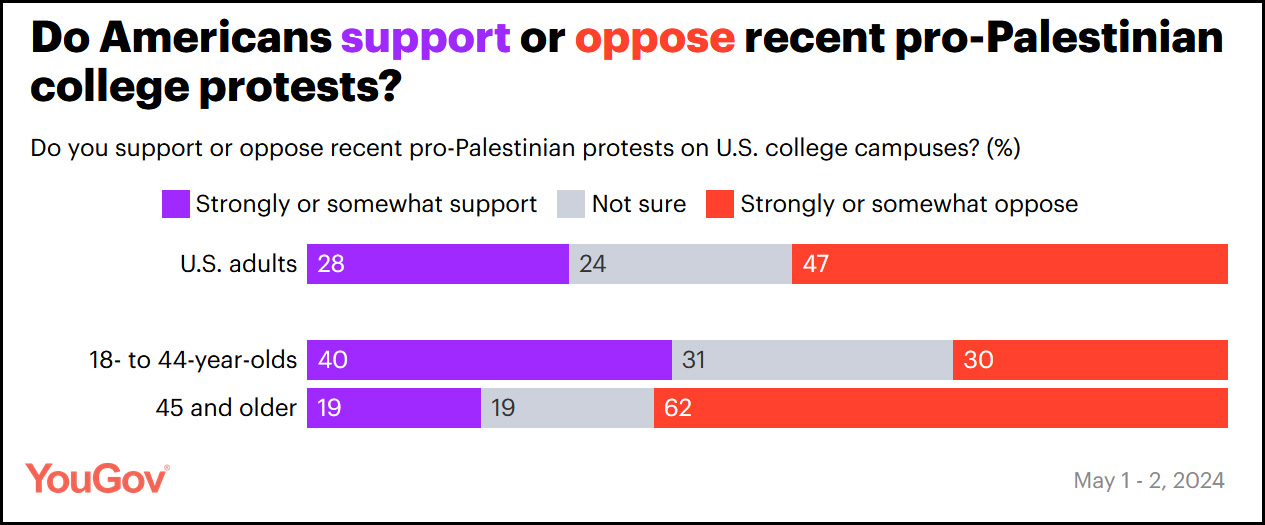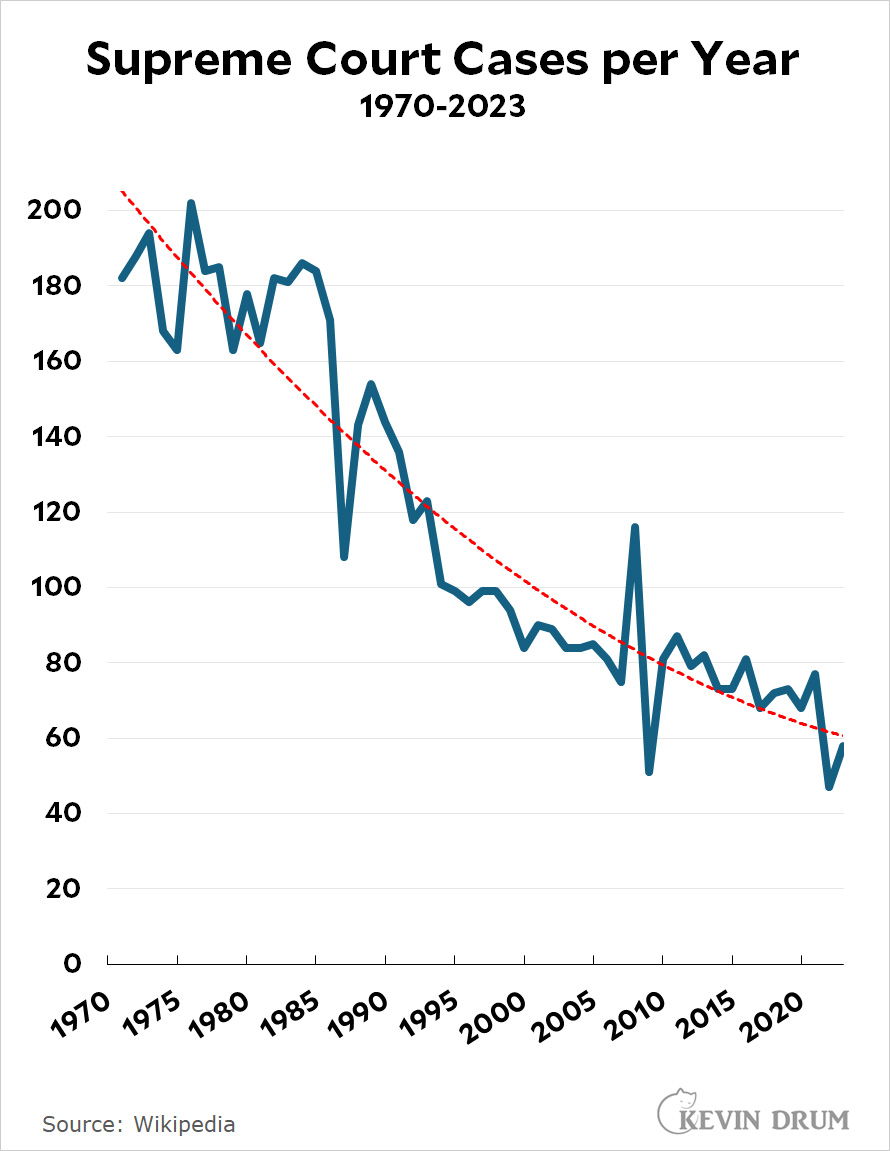The number of cases decided by the Supreme Court has plummeted over the past 50 years:
Do women get the short end of the health care stick?
LA Times culture critic Mary McNamara is oddly angry about the fact that Ozempic can sometimes make women more fertile. I say "oddly" because this is just one of the hundreds of side effects of popular drugs and no one even knows if it's very common. Most of the evidence so far is from TikTok, and research is ongoing.
Anyway, this quickly turns into a more general complaint:
Conditions that predominantly affect men also receive more attention and funding than those that affect women: Despite ranking fifth in lethality among cancers, for instance, ovarian cancer comes 12th in terms of the resources devoted to it.
I get a little tired of this stuff. Ovarian cancer has a high death rate, but it's also uncommon and thus has only a small number of deaths. It ranks around 14th in actual deaths, so 12th in resources is about what you'd expect.
Besides, why cherry pick ovarian cancer when there's a far more obvious comparison available? The two most common cancers, prostate cancer and breast cancer, are nearly identical. They both produce about 300,000 new cases and 40,000 deaths per year. But breast cancer receives more than twice the funding of prostate cancer and about a thousand times more publicity.
The other evidence of bias against women is equally thin. McNamara links to a study suggesting that illnesses that mostly affect women get less funding, but this turns out to be based largely on things like mental illness and migraines, which affect women only modestly more than men. In any case, six of the eight most burdensome diseases affect mostly women, while five of the eight most funded diseases affect mostly women. That's not a big difference.
I wouldn't bring this up except that it's all too common. We've become far too insistent that the medical industry must be unfair to women and minorities just because it has been historically. So writers keep lazily googling and linking to the same few studies, most of which are either low quality or don't say what activists think they say. Biases surely remain in health care, but they're nowhere near as widespread as a lot of people seem to believe. Tuskegee ended more than 50 years ago. Black maternal mortality is unlikely to be a result of racism. Women are not excluded from clinical research studies. Medical students don't have lots of false racial misconceptions. Depression, breast cancer, and other "women's diseases" get tons of funding. Medicare doesn't cover Viagra.
I understand the desire to stay focused on bias and mistreatment in health care, but we shouldn't do it at the expense of promoting outdated and discredited narratives that have long since become little more than urban legends.
Israel through young and old eyes
Opinion about the Gaza protests at college campuses obviously differs between Muslims and Jews and between Republicans and Democrats. But the key difference is this one:
 The experience of older Americans was shaped by an era in which Israel was repeatedly attacked by Arab states (and nonstates) and was forced to defend itself against relentless Palestinian terrorism. It may have since become a brutal, paranoid country, but oldsters understand why it's become that way and therefore retain some sympathy for Israel.
The experience of older Americans was shaped by an era in which Israel was repeatedly attacked by Arab states (and nonstates) and was forced to defend itself against relentless Palestinian terrorism. It may have since become a brutal, paranoid country, but oldsters understand why it's become that way and therefore retain some sympathy for Israel.
Younger Americans have experienced none of that. They've grown up almost exclusively in the Netanyahu era, during which Israel blockaded Gaza; built up the West Bank in a way deliberately intended to eliminate any possibility of a Palestinian state; and kept Palestinians under harsh military occupation. Palestinians have been (relatively) peaceful over the past 20 years but Israel has nonetheless treated them viciously and oppressively for seemingly little reason.
Of course, old people eventually die, and Israel shows no signs of changing its ways. In another 20 years there will be almost no one left who remembers anything good about the country.
Friday Cat Blogging – 3 May 2024
Charlie has been under the weather a bit, so we finally took him to the vet and shot him up with antibiotics. He perked up immediately and, as you can see, is looking fine now.
However, the whole affair was traumatic for Hilbert. As soon as he saw us put Charlie in the cat carrier he ran away and hid.
Job growth slows in April
The American economy gained 175,000 jobs last month. We need 90,000 new jobs just to keep up with population growth, which means that net job growth clocked in at 85,000 jobs. Yuck. The headline unemployment rate ticked up to 3.9%.
 Average weekly earnings dropped 1.1% in April on an annualized basis. Adjusted for inflation, that's a decline of nearly 6%. That's a big drop. The Fed certainly shouldn't have any further illusions about the economy overheating or worker pay increases driving inflation.
Average weekly earnings dropped 1.1% in April on an annualized basis. Adjusted for inflation, that's a decline of nearly 6%. That's a big drop. The Fed certainly shouldn't have any further illusions about the economy overheating or worker pay increases driving inflation.
Everything is fake, according to Donald Trump
Things that are fake according to Donald Trump:
Crime statistics from the FBI.
Job figures from the Bureau of Labor Statistics.
2020 election results from half a dozen different state officials.
Reports that he continually falls asleep during his hush money trial, confirmed by numerous eyewitnesses.
The trial itself, being conducted by the state of New York.
News that he said Alvin Bragg should be prosecuted, recorded on video.
Lunchtime Photo
Banning cell phones in school is a no-brainer
The Washington Post has a story about yet another school that uses Yondr pouches to prevent cell phone use during the day:
Administrators said some of the changes among students have surprised them. Group vaping sessions where students would coordinate to meet in restrooms to smoke prohibited electronic cigarettes? Finished. Using AirDrop to share inappropriate photos during class? No more. Social-media-fueled arguments during school? Over.
Interesting! But what was more interesting was the anecdotal evidence that after a little while even the students themselves liked it:
Multiple students have told him they feel like they are making more friends. His gut also tells him that “the angsty intensity kids are living under” — he mimicked a person with head down, lost in a screen — has diminished.
Students confirmed that the disappearance of cellphones has, in turn, stimulated something old-fashioned.... When the pouches first arrived, “everyone was miserable and no one was talking to each other,” he said. Now he can hear the difference at lunch and in the hallways. It’s louder. Students are chatting more “face to face, in person,” Gabe said. “And that’s a crucial part of growing up.”
Some students hadn’t realized how much their phones diverted their focus....It turns out that being separated from your phone for the day isn’t as big a deal as some students feared. “People thought, ‘Oh my God, I’m going to miss so much,’” Nicole said. “You don’t miss anything. Nothing important is happening outside school.”
I have consistently argued that the evidence of cell phones causing serious problems among teens is pretty thin. That's what the evidence says. But I believe this even though my gut feeling agrees entirely with the anti-phone crowd.¹ This article confirms my gut feeling, but of course "we talk more" is hardly evidence that cell phones are genuinely causing depression or suicide or brain rewiring among teens.
In any case, the entire piece is worth reading. Aside from anything else, I continue to believe that the argument for banning cell phones during the school day is very convincing. Whatever else they may or may not do, they're certainly a distraction for kids who are supposed to be paying attention in class. And there's certainly no harm in teens having an oasis away from social media for a few hours every day.
¹I mostly attribute my gut feeling to the fact that I'm 65 and didn't grow up with cell phones. I suspect that this is responsible for a lot of anti-phone sentiment.
Raw data: Productivity growth slowed in Q1
Productivity growth sucked in Q1. It was up 0.3% from the previous quarter, an annualized rate of only 1.2%
Nvidia will sell you a human brain for $200,000
This is an Nvidia NVL72 Blackwell compute node:
 Give or take a bit, it has the compute power of a human brain and is likely to be priced at about $200,000.
Give or take a bit, it has the compute power of a human brain and is likely to be priced at about $200,000.
Seven years ago I thought it would take until 2040 to have something like this for a few thousand dollars. It's obvious now that it will be more like 2030 or so. Maybe sooner. Welcome to the future.
For now, I'll stick to 2033 as my best guess for full AGI at some kind of reasonable price (< $1 million). I'm not sure I even want to guess at when we'll have AGI at an unreasonable price. Five years? That sounds crackers, even to me, but....




